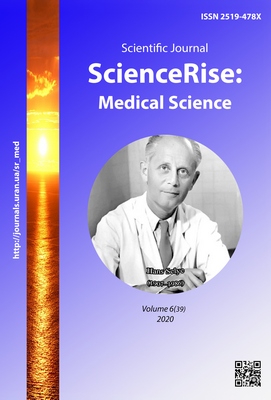Аналіз факторів ризику перинатальної патології у новонароджених з природженими вадами
DOI:
https://doi.org/10.15587/2519-4798.2020.219945Ключові слова:
новонароджені, природжені вади, фактори ризику, шкала A. Coopland.Анотація
Новонароджені з природженими вадами розвитку як правило мають обтяжений перинатальний анамнез, а вагітність їх матерів перебігає на тлі важких ускладнень та загострення хронічної патології. У сучасному акушерстві для визначення ступеня ризику перинатальної та материнської патології використовується безліч орієнтовних шкал, зокрема бальна оцінка за шкалою Coopland.
Мета. Провести клініко-епідеміологічний аналіз перинатальних і материнських факторів ризику за шкалою A. Coopland і проаналізувати частоту реалізації перинатальної патології у новонароджених з природженими вадами в ранньому неонатальному періоді.
Матеріали та методи дослідження. Ретроспективно селективно проаналізовано 88 історій пологів матерів новонароджених з природженими вадами, які отримали хірургічне лікування в неонатальному центрі та проведена бальна оцінка факторів ризику перинатальної та материнської патології за шкалою A. Coopland.
Результати дослідження. Виявлено, що матері новонароджених з природженими вадами входили в групи високого (3 - 6 балів) і дуже високого (7 і більш) прогнозованого ризику перинатальної і материнської патології. У групу високого ризику ввійшли 28 (32%) матерів, а 60 жінка (68%) - у групу дуже високого ризику перинатальної і материнської патології.
Висновки. У жінок з обтяженим перебігом вагітності, що мають більш 15 балів за шкалою A. Coopland, у 4,7 рази частіше народжувалися діти з реалізацією внутрішньоутробної інфекції, гастроінтестинальними порушеннями, некротизуючим ентероколітом і важкими респіраторними порушеннями у ранньому неонатальному періоді, порівняно з матерями, що народили новонароджених з таким же терміном гестації і групою низького і високого ризику щодо перинатальної і материнської патології
Посилання
- Horbatiuk, O. M. (2011). Suchasnyi stan khirurhii novonarodzhenykh v Ukraini ta perspektyvy rozvytku. Neonatolohiia, khirurhiia ta perynatalna medytsyna, 1, 17–20. Available at: http://nbuv.gov.ua/UJRN/Nkhpm_2011_1_1_5
- Korytskyi, H. I., Horbatiuk, O. M. (2014). Suchasni realii ta perspektyvy neonatalnoi khirurhichnoi sluzhby na Ternopilshchyni. Sovremennaia pedyatryia, 3, 44–47. Available at: http://nbuv.gov.ua/UJRN/Sped_2014_3_11
- Vlasov, O. O. (2020). Condition of problems of congenital developments and surgical diseases in the newborn in ukraine and the dnepropetrovsk region. Neonatology, Surgery and Perinatal Medicine, 10 (1 (35)), 6–13. doi: http://doi.org/10.24061/2413-4260.x.1.35.2020.1
- Markevych, V. V. (2016). Osoblyvosti medyko-sotsialnoi kharakterystyky pershorodilei riznykh vikovykh hrup. Health of woman, 1 (107), 91–93.
- Tarasyuk O. K., Storozhuk, M. S. (2014). Special characteristics of pregnancy and delivery course in women over 30. Actual Problems of Pediatrics, Obstetrics and Gynecology, 2. doi: http://doi.org/10.11603/24116-4944.2014.2.5899
- Pro orhanizatsiiu nadannia statsionarnoi akushersko-hinekolohichnoi ta neonatalnoi dopomohy v Ukraini (2003). Nakaz MOZ Ukrainy No. 620. 29.12.03. Kyiv, 275.
- Tawfeeq Al-kassab, M. M. (2001). Using Discriminant Function to Classify the Pregnants According to Coopland Risk Scale. Available at: https://www.researchgate.net/publication/339941657_Using_Discriminant_Function_to_Classify_the_Pregnants_According_to_Coopland_Risk_Scale
- Trammell, B. A. (2012). The maternal perinatal scale as a predictor of developmental risk. Indiana, 137.
- Usman, U. I., Balogun, O. S. (2015). On the use of discriminant analysis in classification of the mode of delivery of an expectant mother. International Journal of Innovation and Scientific Research, 17 (2), 241–245. Available at: https://www.researchgate.net/publication/281294084_ON_THE_USE_OF_DISCRIMINANT_ANALYSIS_IN_CLASSIFICATION_OF_THE_MODE_OF_DELIVERY_OF_AN_EXPECTANT_MOTHER
- Levchenko, L. A. (2011). Analyz faktorov ryska razvytyia vnutryutrobnikh pnevmonyi u nedonoshennikh novorozhdёnnikh. Ukrainskyi medychnyi almanakh, 14 (3), 99–101.
##submission.downloads##
Опубліковано
Як цитувати
Номер
Розділ
Ліцензія
Авторське право (c) 2020 Aleksey Vlasov

Ця робота ліцензується відповідно до Creative Commons Attribution 4.0 International License.
Наше видання використовує положення про авторські права Creative Commons CC BY для журналів відкритого доступу.
Автори, які публікуються у цьому журналі, погоджуються з наступними умовами:
1. Автори залишають за собою право на авторство своєї роботи та передають журналу право першої публікації цієї роботи на умовах ліцензії Creative Commons CC BY, котра дозволяє іншим особам вільно розповсюджувати опубліковану роботу з обов'язковим посиланням на авторів оригінальної роботи та першу публікацію роботи у цьому журналі.
2. Автори мають право укладати самостійні додаткові угоди щодо неексклюзивного розповсюдження роботи у тому вигляді, в якому вона була опублікована цим журналом (наприклад, розміщувати роботу в електронному сховищі установи або публікувати у складі монографії), за умови збереження посилання на першу публікацію роботи у цьому журналі.










